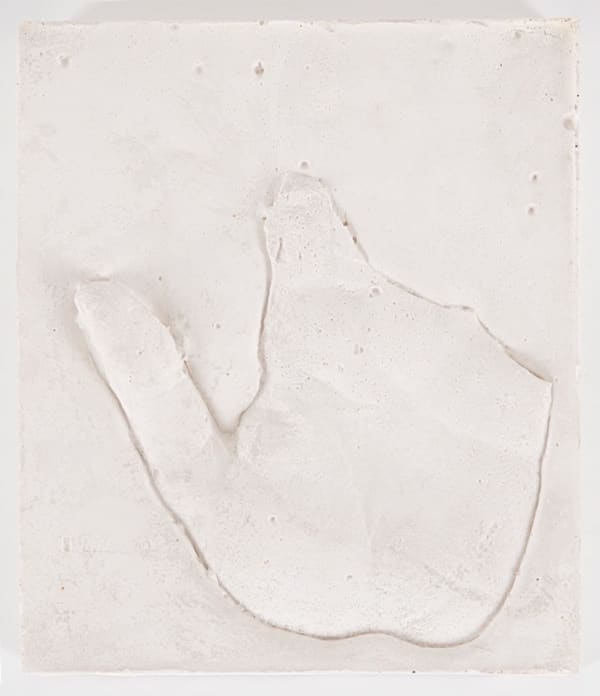-
Galerie Peter Kilchmann is pleased to present its third solo exhibition dedicated to Vlassis Caniaris (1928-2011), which also marks the first major retrospective in France since his passing. The artist had a special connection to Paris, where he lived twice with his family, from 1960 to 1966 and again from 1969 to 1976. In 1970, he was granted a solo exhibition at the Musée d’Art Moderne de la Ville de Paris.
-
-
The work of Caniaris stands out for its immediate historical context, sincerely concerned with the socio-political conditions shaping human destinies. Raised in a climate marked by war and occupation in Greece, Caniaris developed an early awareness of injustice and the imbalances of power. Social aspirations and the appearances they take on are, of course, distorted in relation to the real psychological needs of the individuals within these societies. For Caniaris, art is a field that must embody “[…] two driving forces: […] the ambition to develop and exploit artistic work as a global tool, capable of establishing a diagnosis and a sharp, lucid vision of social, cultural, and personal asymmetries in order to [...] expose the pathological symptoms of industrialized societies [… ultimately], a means to acquire ideas and shed light on them.”
-

Vlassis Caniaris, Urinal of History, 1980, environment with 3 standing figures made of metal frame and clothing, painted wall paper on canvas, wall paper on canvas: 234 x 1007 cm, figures: 153 x 57 x 30 cm, 141 x 57 x 30 cm, 146 x 57 x 40 cm, unique
-
The exhibition brings together sculptures, assemblages, installations, and works on paper created between 1962 and 1980 during the artist’s stays in Paris, Berlin, and Athens. It focuses on major contextual phases that brought about significant shifts in his practice. Among the themes addressed are the critique of post-war economic growth, resistance to the consequences of the military coup in Greece, and the fate of immigrant workers (Gastarbeiter) in Germany, as well as broader issues related to immigration. Initially trained as a painter, Caniaris first transcended the Albertian perspective of the "work as a window onto the world." Instead, he concentrated on fundamental objects that exceed the idea of the frame. He then moved toward more situational and installation-based works. The large-scale installation Hélas-Hellas can be seen as the culmination of this research, summing up what Caniaris experienced and explored as both an artist and an individual over two decades spent in shifting socio-political contexts.
-
In 1960, after spending five years in Rome, Caniaris moved to Paris and became acquainted with the Nouveaux Réalistes. He abandoned traditional painting on canvas and began to work with humble, everyday materials such as wire mesh, iron wire, and plaster. Unlike his French contemporaries, he was not swept up in the enthusiasm for new objects produced by a consumer society. Instead, he observed the illusory and disappointing nature of a world that, in his view, failed to deliver on its promises of happiness, security, or progress. The sculpture Only this (1962) is part of his series of “works on the economic miracle,” initiated in Paris in 1961. This assemblage consists of various fabric scraps draped over a spiral-shaped wire structure and held together with glue. This concrete sculpture represents nothing more than what it is: a demonstration of the ennobling techniques adopted by consumer culture within a dynamic of commodified aestheticization. The material is unsuitable, the form dysfunctional.
The sculpture Coexistence (1964) belongs to the same group. A worn-out shirt is tightly wrapped around a small electric heater. The assemblage of these two elements reveals a practical dysfunction and evokes the very obstruction that cohabitation imposes on each element: the former cannot provide warmth, and the latter cannot heat.
-

-
In 1966, one year before the military junta (also known as the Dictatorship of the Colonels) abolished Greek democracy, Caniaris returned to Athens. His 1969 exhibition at the New Gallery in Athens, which featured constructions made of plaster and barbed wire, provoked strong reactions—not only for its unique and fundamentally new artistic approach, but also for its denunciation of the dictatorship. Actively involved in a resistance group, the artist was soon forced to leave Athens and take refuge in Paris. The following year, the same exhibition was shown at the Musée d’Art Moderne in Paris.
The works in this “anti-dictatorial” series feature everyday objects such as shoes, plastic carnations, or children's toys—as seen in Untitled (1970)—which the artist immersed in plaster. Serving as metaphors for the state of Greek society, “cast” under the military dictatorship, they appear suspended in time, waiting to be set free.
-
Between 1973 and 1976, thanks to a DAAD scholarship, Caniaris settled in Berlin and created the Gastarbeiter–Fremdarbeiter series, inspired by the world of Turkish, Italian, and Greek migrant workers living in Germany. The installations feature wire figures combined with everyday objects. This approach allowed the artist to portray the human condition in an even more radical way—individuals are now transformed into objects.
-
-

In the installation Untitled (1974), Caniaris assembles parts of a wooden floor—covered with pieces of cheap carpet—on which rests a bargain bin overflowing with various items and toys, alongside a child figure made from wool stockings standing next to a baby chair. The domestic environment is bare and impoverished. Caniaris powerfully conveys the precarious and improvised atmosphere of the space, evoking the homes of many immigrant workers of the time.
There is no drama or superfluous effect, however; instead, he adopts a precise and unflinching gaze, marked by meticulous attention to objects—their placement, their colors, their stains, their folds, and every minute detail. He favors simplicity, capturing with remarkable accuracy the essence of such situations, thereby creating room for a kind of “inhabitability” of objects, in which the soul of an entire generation of migrants seems to dwell.
-
In the assemblage Plus and Minus (1974), the artist uses two cans: each symbolizes a different world, the promise of opportunities versus the harshness of reality. One, with a recognizable American brand label, evokes the allure of the West, often idealized as a land of success and prosperity. However, the barbed wire protruding from it forms a powerful symbol of restriction and confinement, referencing the physical and symbolic barriers faced by immigrants. The other can, labeled with a Greek brand, is filled with ordinary stones. The juxtaposition of these two cans illustrates the tension between the hopes for a better life and the unforgiving realities that immigrant workers must confront.
-
 Vlassis Caniaris, Plus and Minus, 1974, tin cans, barbed wire, stones, 27 x 34.5 x 24 cm, framed, (within plexiglass), variation (series)
Vlassis Caniaris, Plus and Minus, 1974, tin cans, barbed wire, stones, 27 x 34.5 x 24 cm, framed, (within plexiglass), variation (series) -
In 1976, Caniaris was appointed professor and head of the art section at the School of Architecture of the National Polytechnic University of Athens, where he returned. The monumental installation Urinals of History (1980) features three life-sized figures. Made of wire mesh, they are positioned to mimic the act of urinating against a wall. This wall is covered in red, blue, and green graffiti, reminiscent of the political slogans that were scrawled on the walls of Athens during the Nazi Occupation, the Civil War (1946-1949), and the military dictatorship. The graffiti also echoes Caniaris’ series of paintings titled Homage to the Walls of Athens. These three men, who could be described as "politically indifferent," urinate against a wall that, despite being disfigured by graffiti and slogans, remains a metaphor for the collective effort of the Greeks to erase the memory of their past by vandalizing their heritage. For Caniaris, this wall held a particular significance, as it alluded to the very structure of their lives. The artist described his sculptural figures as "witnesses" and placed the visitors on the same representational level as these figures: both objects, observers, and participants—thus occupying a radically open position, one he himself adopted in his life and work. Urinals of History was first exhibited in 1980 during the Hélas-Hellas exhibition in Athens, marking a decisive turning point in the artist's career.
-
-
Vlassis Caniaris is considered one of the most important protagonists of Greek post-war art. He changed the dynamics of the Greek art scene and his distinctive visual language was cutting-edge for his time and earned him invitations to exhibit at the Venice Biennale (1964, 1988, 2003, 2013) and documenta 6 and 14 in Kassel (1977, 2017). Relevant early solo exhibitions include the Musée d’Art Moderne de la Ville de Paris (1970); Moderna Museet, Stockholm (1972); ICA Institute of Contemporary Arts, London (1976); Kunstverein Hannover (1976) and National Gallery, Retrospective, Athens (1999). More recent solo shows were held at the The Hellenic Centre, London (2023); Cultural Foundation of Tinos, Greece (2016); Wiels Centre d’Art Contemporain, Brussels, (2015); Kadel Willborn Kunstgalerie, Düsseldorf (2015); The Breeder, Monaco (2013); GAK - Gesellschaft für Aktuelle Kunst, Bremen (2012); Henry Moore Institute, Leeds (2012); Team Gallery, NY (2011) and the Benaki Museum, Athens (2009). He participated at group shows at MKK, Frankfurt (2024); National Gallery Athen (2024 & 2023); Kunstmuseum Bochum (2021); Palazzo Reale, Milan (2021); Musem am Ostwall, Dortmund (2020); Megaron The Athens Concert Hall (2018); Akademie der Künste, Berlin (2016); Palais des Beaux Arts, Bruxelles (2014); European Parliament, Bruxelles (2014); Gwangju Biennale (2014); Municipal Gallery of Athen, Athen (2014); Palais de Tokyo, Paris (2013); National Archeological Museum, Athen (2013); Venice Biennale (2013, cur. Massimiliano Gioni); Faggionato Gallery, London (2011); Thessaloniki Biennale (2011) and Centre Pompidou, Paris (1997 & 1996). Works by Caniaris are found in the collections of the following institutions (selection): Fonds National d'Art Contemporain, Paris; Musée d’Art Moderne de SaintÉtienne; MMCA Macedonian Museum of Contemporary Art, Thessaloniki; Museum of Modern Art, Warsaw; National Art Gallery - Alexandros Soutzos Museum, Athens; National Museum of Contemporary Art - EMST, Athens; Pinakothek der Moderne, Munich; the Museum am Ostwall, Dortmund; SMAK Stedelijk Museum voor Actuele Kunst, Gent; Ludwig Museum Cologne, Tate Modern, London and The Israel Museum, Jerusalem.
Galerie Peter Kilchmann
11-13 rue des Arquebusiers, Paris
, 21 March - 10 May 2025Be the first to know updates about Galerie Peter Kilchmann
* denotes required fields
We will process the personal data you have supplied to communicate with you in accordance with our Privacy Policy. You can unsubscribe or change your preferences at any time by clicking the link in our emails.
























